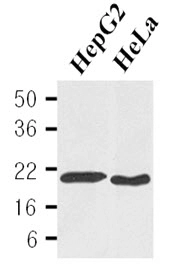![FACS analysis of U2OS cells using GTX04262 Cyclophilin B antibody [11C11]. Antibody amount : 1microg/1x106 cells Blue : Primary antibody Green : Isotype control Red : Unlabelled sample FACS analysis of U2OS cells using GTX04262 Cyclophilin B antibody [11C11]. Antibody amount : 1microg/1x106 cells Blue : Primary antibody Green : Isotype control Red : Unlabelled sample](https://www.genetex.com/upload/website/prouct_img/normal/GTX04262/GTX04262_20230218_FACS_23021722_720.webp)
FACS analysis of U2OS cells using GTX04262 Cyclophilin B antibody [11C11]. Antibody amount : 1microg/1x106 cells Blue : Primary antibody Green : Isotype control Red : Unlabelled sample
Cyclophilin B antibody [11C11]
GTX04262
ApplicationsFlow Cytometry, ImmunoFluorescence, Western Blot, ImmunoCytoChemistry, ImmunoHistoChemistry, ImmunoHistoChemistry Paraffin
Product group Antibodies
TargetPPIB
Overview
- SupplierGeneTex
- Product NameCyclophilin B antibody [11C11]
- Delivery Days Customer9
- Application Supplier NoteWB: 0.1-0.5 microg/mL. ICC/IF: 2 microg/mL. IHC-P: 0.5-1 microg/mL. FACS: 1-3 microg/106 cells. *Optimal dilutions/concentrations should be determined by the researcher.Not tested in other applications.
- ApplicationsFlow Cytometry, ImmunoFluorescence, Western Blot, ImmunoCytoChemistry, ImmunoHistoChemistry, ImmunoHistoChemistry Paraffin
- CertificationResearch Use Only
- ClonalityMonoclonal
- Clone ID11C11
- Concentration0.5 mg/ml
- ConjugateUnconjugated
- Gene ID5479
- Target namePPIB
- Target descriptionpeptidylprolyl isomerase B
- Target synonymsB; cyclophilin-like protein; CYPB; CYP-S1; epididymis secretory protein Li 39; HEL-S-39; OI9; peptidyl-prolyl cis-trans isomerase B; peptidylprolyl isomerase B (cyclophilin B); PPIase B; rotamase B; S-cyclophilin; SCYLP
- HostMouse
- IsotypeIgG1
- Protein IDP23284
- Protein NamePeptidyl-prolyl cis-trans isomerase B
- Scientific DescriptionThe protein encoded by this gene is a cyclosporine-binding protein and is mainly located within the endoplasmic reticulum. It is associated with the secretory pathway and released in biological fluids. This protein can bind to cells derived from T- and B-lymphocytes, and may regulate cyclosporine A-mediated immunosuppression. Variants have been identified in this protein that give rise to recessive forms of osteogenesis imperfecta. [provided by RefSeq, Oct 2009]
- Storage Instruction-20°C or -80°C,2°C to 8°C
- UNSPSC12352203

![ICC/IF analysis of U2OS cells using GTX04262 Cyclophilin B antibody [11C11]. Antigen retrieval : Heat mediated EDTA buffer (pH 8.0, epitope retrieval solution) Dilution : 2 microg/mL ICC/IF analysis of U2OS cells using GTX04262 Cyclophilin B antibody [11C11]. Antigen retrieval : Heat mediated EDTA buffer (pH 8.0, epitope retrieval solution) Dilution : 2 microg/mL](https://www.genetex.com/upload/website/prouct_img/normal/GTX04262/GTX04262_20230218_ICCIF_23021722_377.webp)
![IHC-P analysis of human ovarian cancer tissue using GTX04262 Cyclophilin B antibody [11C11]. Antigen retrieval : Heat mediated EDTA buffer (pH 8.0, epitope retrieval solution) Dilution : 1 microg/mL IHC-P analysis of human ovarian cancer tissue using GTX04262 Cyclophilin B antibody [11C11]. Antigen retrieval : Heat mediated EDTA buffer (pH 8.0, epitope retrieval solution) Dilution : 1 microg/mL](https://www.genetex.com/upload/website/prouct_img/normal/GTX04262/GTX04262_20230218_IHC-P_1_23021722_523.webp)
![IHC-P analysis of human placenta tissue using GTX04262 Cyclophilin B antibody [11C11]. Antigen retrieval : Heat mediated EDTA buffer (pH 8.0, epitope retrieval solution) Dilution : 1 microg/mL IHC-P analysis of human placenta tissue using GTX04262 Cyclophilin B antibody [11C11]. Antigen retrieval : Heat mediated EDTA buffer (pH 8.0, epitope retrieval solution) Dilution : 1 microg/mL](https://www.genetex.com/upload/website/prouct_img/normal/GTX04262/GTX04262_20230218_IHC-P_2_23021722_509.webp)
![IHC-P analysis of human oesophagus squama cancer tissue using GTX04262 Cyclophilin B antibody [11C11]. Antigen retrieval : Heat mediated EDTA buffer (pH 8.0, epitope retrieval solution) Dilution : 1 microg/mL IHC-P analysis of human oesophagus squama cancer tissue using GTX04262 Cyclophilin B antibody [11C11]. Antigen retrieval : Heat mediated EDTA buffer (pH 8.0, epitope retrieval solution) Dilution : 1 microg/mL](https://www.genetex.com/upload/website/prouct_img/normal/GTX04262/GTX04262_20230218_IHC-P_23021722_597.webp)
![IHC-P analysis of human tonsil tissue using GTX04262 Cyclophilin B antibody [11C11]. Antigen retrieval : Heat mediated EDTA buffer (pH 8.0, epitope retrieval solution) Dilution : 1 microg/mL IHC-P analysis of human tonsil tissue using GTX04262 Cyclophilin B antibody [11C11]. Antigen retrieval : Heat mediated EDTA buffer (pH 8.0, epitope retrieval solution) Dilution : 1 microg/mL](https://www.genetex.com/upload/website/prouct_img/normal/GTX04262/GTX04262_20230218_IHC-P_3_23021722_425.webp)
![IHC-P analysis of human lung cancer tissue using GTX04262 Cyclophilin B antibody [11C11]. Antigen retrieval : Heat mediated EDTA buffer (pH 8.0, epitope retrieval solution) Dilution : 1 microg/mL IHC-P analysis of human lung cancer tissue using GTX04262 Cyclophilin B antibody [11C11]. Antigen retrieval : Heat mediated EDTA buffer (pH 8.0, epitope retrieval solution) Dilution : 1 microg/mL](https://www.genetex.com/upload/website/prouct_img/normal/GTX04262/GTX04262_20230218_IHC-P_4_23021722_836.webp)
![WB analysis of various tissue lysates using GTX04262 Cyclophilin B antibody [11C11]. Loading : 50 microg Dilution : 0.5 microg/mL WB analysis of various tissue lysates using GTX04262 Cyclophilin B antibody [11C11]. Loading : 50 microg Dilution : 0.5 microg/mL](https://www.genetex.com/upload/website/prouct_img/normal/GTX04262/GTX04262_20230218_WB_1_23021722_233.webp)
![WB analysis of various sample lysates using GTX04262 Cyclophilin B antibody [11C11]. Loading : 50 microg Dilution : 0.5 microg/mL WB analysis of various sample lysates using GTX04262 Cyclophilin B antibody [11C11]. Loading : 50 microg Dilution : 0.5 microg/mL](https://www.genetex.com/upload/website/prouct_img/normal/GTX04262/GTX04262_20230218_WB_23021722_837.webp)


![IHC-P analysis of human uterus tissue using GTX34135 Cyclophilin B antibody [2B10]. Negative control (the lower left coner) was secondary antibody only. Antigen retrieval : Sodium citrate pH6.0 was used for antibody retrieval (>98oC, 20min) Dilution : 1:200](https://www.genetex.com/upload/website/prouct_img/normal/GTX34135/GTX34135_20200622_IHC-P_081_w_23060801_919.webp)
![IHC-P analysis of human heptacarcinoma tissue using GTX34136 Cyclophilin B antibody [1B3]. Dilution : 1:200](https://www.genetex.com/upload/website/prouct_img/normal/GTX34136/GTX34136_20200622_IHC-P_312_w_23060801_343.webp)
